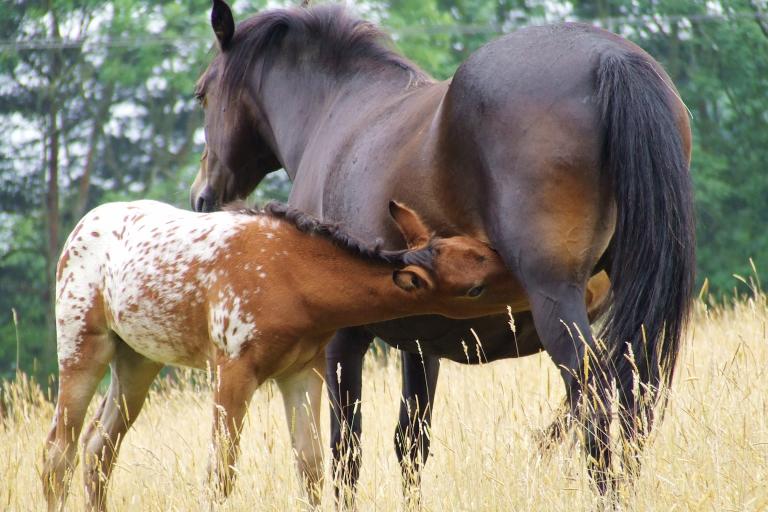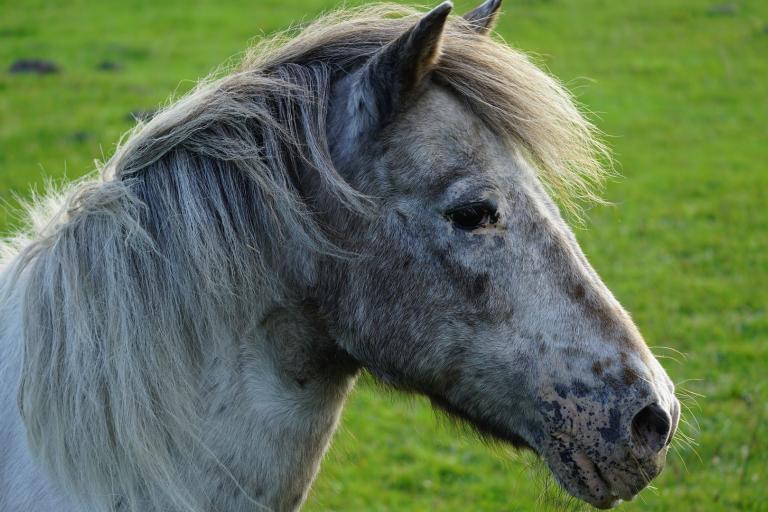Leopard-Complex | Appaloosa (Coat colour pattern Horse)
The Leopard-Complex leads to extensive white colouration on the hip region or the whole body with pigmented spots ("leopard spots"). There is a great variety of pattern expression: Variable amount of white, variable pigmentation of the spots, spots with and without fringe etc., the exact genetics of the pattern (distribution) is not yet fully understood.
Other characteristic traits are white stripes on hooves, visible white sclera in eyes, speckled/mottled skin around the eyes, muzzle and genital regions, progressive “varnish roan” coat color.
The pattern 1 mutation can strongly influence the amount of white in leopard spotted horses.
Leopard-Complex is associated with the Congenital Stationary Nightblindness (CSNB) if two copies (LP/LP) are present.
General Information
- The Leopard-Complex leads to extensive white colouration on the hip region or the whole body with pigmented spots ("leopard spots").
- Great variety of pattern expression: Variable amount of white, variable pigmentation of the spots, spots with and without fringe etc., the exact genetics of the pattern (distribution) is not yet fully understood.
- The pattern 1 mutation can strongly influence the amount of white in leopard spotted horses.
- Few Spot: Extreme amount of white, only a few coloured spots. (mostly LP/LP + PATN1)
- Full Leopard: Coloured spots on the otherwise white body. (often LP/n, LP/LP + PATN1)
- Blanket: Variable white "blanket" over hips and back with coloured spots. (often LP/n, LP/LP without PATN1)
- Snowflake: Coloured body with small white spots. (LP/n ?)
- Varnish Roan: Coloured body with white roan pattern, which may increase with age. (LP/n ?)
- Solid:Solid coloured horse, usually with other visible characteristic traits. (LP/n ?)
- Characteristic traits: white stripes on hooves, visible white sclera in eyes, speckled/mottled skin around the eyes, muzzle and genital regions, progressive “varnish roan” coat color.
- The Appaloosa, Knabstrupper and Pony of the Americas breeds are known for their Leopard spotting, but it also occurs in other breeds.
Associated disease
Congenital Stationary Nightblindness (CSNB)
Leopard-Complex is associated with the Congenital Stationary Nightblindness (CSNB) if two copies are present.
Affected horses are usually night-blind, i.e. they cannot see at dusk and in the dark.
Test Information
Locus Information: LP Locus
This test detects an insertion in the TRPM1 gene.
Genotype and Lab Report
Inheritance: incomplete autosomal-dominant
→ Incomplete means that horses with one copy of the variant (n/LP) will show a less pronounced phenotype than horses with two copies of the variant (LP/LP).
Genotype
n/n = No Leopard-Complex mutation
Das Pferd zeigt keine Scheckung.
LP/n = One copy of the LP-variant
Leopard pattern with wide variety of phenotypes (e.g. frost, roan, blanket, leopard).
LP/LP = Two copies of the LP-variant
Fewer leopard spots on white areas (e.g. full leopard, few spot). Horses are also affected by CSNB.
→ Other genes may influence the phenotype. Pattern-1 is one known mutation that alters the amount of white in leopard horses.
Appearance
Literature
Bellone, R.R., Holl, H., Setaluri, V., Devi, S., Maddodi, N., Archer, S., Sandmeyer, L., Ludwig, A., Foerster, D., Pruvost, M., Reissmann, M., Bortfeldt, R., Adelson, D.L., Lim, S.L., Nelson, J., Haase, B., Engensteiner, M., Leeb, T., Forsyth, G., Mienaltowski, M.J., Mahadevan, P., Hofreiter, M., Paijmans, J.L., Gonzalez-Fortes, G., Grahn, B., Brooks, S.A.: Evidence for a retroviral insertion in TRPM1 as the cause of congenital stationary night blindness and leopard complex spotting in the horse. PLoS One 8:e78280, 2013. Pubmed reference: 24167615. Doi: 10.1371/journal.pone.0078280.
Further information is available at Online Mendelian Inheritance in Animals.



